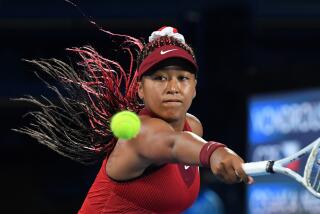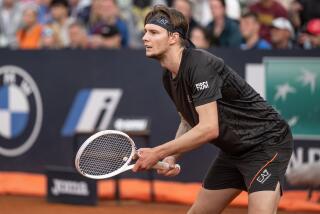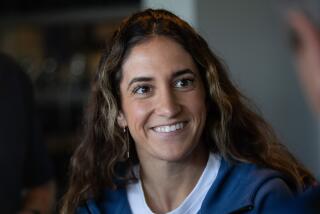Sharapova Will Grow On You
- Share via
From Melbourne to Paris to Wimbledon, there was a recurring thought this year whenever Maria Sharapova walked into an interview room or strode onto a tennis court.
Had Sharapova gotten taller or was everyone else just shrinking?
The mystery was solved Monday. Listed at 6 feet in the WTA Tour media guide, Sharapova said she was 6-2, having grown a few more centimeters, which may have contributed to her back problems in 2005.
Does this height come from her rarely-seen mother, Yelena, or some great-grandfather? Well, Yelena is 5-7, and Sharapova dismissed the other theory. She, too, is curious.
“No, I would know. I’ve been asking,” Sharapova said, laughing.
The 18-year-old Sharapova is poised and shows an impressive ability to stay on message. But every so often, there is a glimpse of the teenager, as opposed to the “global brand,” when she giggles.
Her biggest burst of laughter came when she talked about doing something else when she was 30, guaranteeing she would not be playing tennis, speaking about fashion, possibly working as an intern for a designer, and eventually starting a family.
“I don’t want to be 35 and not have a family, you know,” she said.
That statement took seconds to sink in, hitting her as rather premature, as she looked at the handful of reporters sitting around her in the Stadium Club at the Home Depot Center in Carson.
“I’m 18 and talking about a family with you guys,” she said, giggling. “There’s more to life -- I just feel like I want to explore so many more things in life than tennis. I love fashion and I can’t go to fashion school.”
There are a few more things on her to-do list before it reaches that stage. The No. 1 ranking, for one, but most assuredly, there is not the word “urgent” written in red capital letters next to it.
The JPMorgan Chase Open, which started Monday in Carson, is Sharapova’s first event since failing to defend her Wimbledon title in July.
But since Sharapova is a few strokes away from overtaking No. 1-ranked Lindsay Davenport -- she needs to reach the semifinals in Carson and pick up some bonus points to do so -- there were far more questions about the ranking than about her loss to Venus Williams at Wimbledon in the semifinals.
She would become the first Russian female to reach No. 1, and it would be the second time in three years that a change at the top occurred at this tournament. In August 2003, Kim Clijsters of Belgium supplanted Serena Williams at No. 1.
“It’s very important, but if I wanted to be No. 1, I would have played San Diego with a tight back,” said Sharapova, who added that she was fine now. “Lindsay pulled out and I would have had a good chance then. I want to make sure whenever I become No. 1, I’m healthy and ready to stay at No. 1.
“For me to become No. 1 and keep it for one week doesn’t mean anything. ... I’m not working toward No. 1 and then falling down the steps.”
Sharapova came close to the top spot earlier this year but said she wasn’t in a rush to get there. In 2005, she has reached the semifinals of the Australian Open and Wimbledon and the quarterfinals of the French Open, losing to the eventual winner at all three Grand Slams.
She said Monday that she was in severe pain during the Australian Open and that she thought the most recent mini-growth spurt might have been the culprit. It was nothing like her growth spurt two years ago, a surge of about three inches in a few months.
Series Changes?
The U.S. Tennis Assn. owns 25% of the Carson tournament, so there is an understandable concern about the withdrawals of Serena Williams and Davenport, as well as the spate of injuries/absences hitting the U.S. Open Series.
Arlen Kantarian, the USTA’s chief executive of professional tennis, had a meeting with WTA Tour officials on Monday at Carson to discuss the issue, among other things, and said he was “disappointed” in what had been happening. The Acura Classic, which ended Sunday in Carlsbad, was without its four top draws, Sharapova, Davenport, Justine Henin-Hardenne and Serena Williams. The men’s event at UCLA was hit hard, too, losing Andy Roddick, among others.
Possible remedies would be requiring a minimum number of events to qualify for series bonuses, or tying seedings at the U.S. Open to the series. Kantarian took issue with Venus Williams’ decision to play in Stockholm instead of Carson, though she withdrew from the Swedish event because, she said, she was suffering from flu.
“It’s difficult to understand how a player can play a Tier III or Tier IV event in Stockholm,” he said. “Obviously, we have a lot of injuries in this sport. We’ve always said there are too many tournaments year-round, should be fewer tournaments, shorter season. We’ll look at that.
“The global aspect of the sport is our biggest advantage and our biggest disadvantage. This is the one way in which it is a disadvantage.”
More to Read
Go beyond the scoreboard
Get the latest on L.A.'s teams in the daily Sports Report newsletter.
You may occasionally receive promotional content from the Los Angeles Times.











